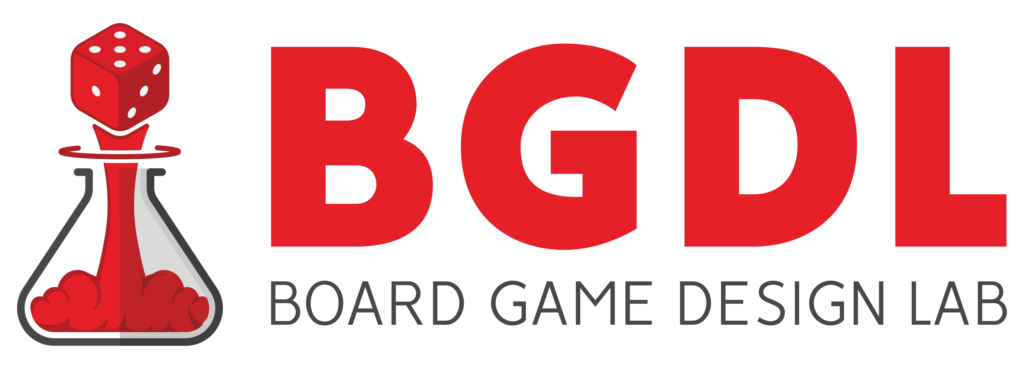Subscribe to the BGDL email list to get exclusive resources and chances to win free games!
How to Get Your Game Published


Get your game in front of publishers and onto store shelves.
After you’ve designed a game, playtested it a bunch, and polished it to completion, you may want to pursue actually getting it on store shelves. Now, please don’t feel any pressure to do this as there’s nothing wrong with creating games that only you and a select few people enjoy. However, if you do want to get your game published, here are some things to think about.
“NEVER rush a design. When it’s ready, it’s ready. If you haven’t tested enough, don’t even try to bring it to market. Take as long as you need to with it.”
— Helaina Cappel
Creating a Product
The main thing to understand if you want people to buy your game is that you’re no longer designing a game as much as you’re designing a product. You can have the greatest game of all time, but if it doesn’t hook people in with its theme, art, graphic design, packaging, price point, etc., then few people are going to buy it.
People often complain that there are too many zombie games on the market, but the truth is that they continue to sell. If they didn’t sell, publishers wouldn’t keep putting them out. So, as you design your game, keep its product-ness in mind.
Be aware of component costs and how much art the final product will need. Think about your target market and what kinds of games they want to play. (If your game is for families, it shouldn’t take two hours to play, etc.) These are the things a publisher will be thinking about, so you’ll need to keep them in mind as well if you want to be successful.
Finding a Publisher
Finding the right fit for your game can be a tough task. You want to make sure your game fits with a company’s line of games, but they also have to be currently open to submissions and have room in their current printing/marketing schedule.
A lot of times, it’s more about “fit” than anything else, so if someone tells you no, don’t take it personally. There are thousands of reasons why they might pass on a game, and most of them have nothing to do with you or the game itself.
When it comes to researching for the right fit, you can start by looking at games that are somewhat similar to yours. Publishers often sell games that cater to a certain audience, so who is your game for? And what companies make games for those people?
It’s also a good idea to ask other game designers what publishers they would recommend for your game. There are a lot of small publishers out there that you’ve likely never heard of, so asking people who have been in the industry for a while might lead you to a good fit for your game.
My favorite resource to find publishers is a database created by Cardboard Edison. It lists a ton of companies, whether or not they’re currently accepting game submissions, their contact info, and the types of games they’re looking for. And the information gets updated regularly. You can access it HERE for a small fee.
“When making a game, you don’t have to innovate if you’re improving on what’s out there. Also, as long as the game experience is new and novel, the mechanisms themselves don’t have to be.”
— Seth Jaffee
Approaching a Publisher
Pitching a game to a publisher typically follows this process:
Email to publisher with short pitch → Publisher requests a sell sheet → Publisher requests meeting → Publisher requests prototype → Publisher assesses game → Publisher offers contract
Now, that process could take a year or more in some situations. Publishers are usually very busy and aren’t just sitting around waiting for you to send them “the best game ever.” And at any point in that process, they could reject your game for a host of different reasons, and most of them don’t even have anything to do with your game. So, please don’t take things personally.
They might not have room in their printing schedule; they might already have a similar game under contract; they might not have room in their budget; etc.
Honestly, the likelihood of getting your game published is very low, however, if you don’t put your game out there, you’re guaranteed to never have a publisher sign it. So, if it’s something you actually want to see happen, stay persistent. If the game really is good enough to be a viable product in the marketplace, a company will eventually pick it up.
When you reach out to companies, make sure to personalize the emails you send. A generic message is much less likely to get a response than one that you craft with that particular publisher in mind.
When you put together a sell sheet (explained below), make sure it looks good and conveys all the necessary information in an attractive and easy to understand way.
When you meet with a publisher, make sure you’ve practiced your pitch and treat the whole thing like a job interview. Give the publisher plenty of time to ask questions, and if you’re able to play your game with them, stack the deck so that the best parts of your game are highlighted. (And try not to win by 100 points.)
When sending in a prototype, make sure it looks great and everything is as polished as possible. You don’t need to spend a bunch of money on art or anything, but it should look “nice” when they play it.
When they’re assessing your game, feel free to send follow-up emails every four to six weeks to check on the progress. Be brief, and don’t be pushy, but just check in to keep the game at the front of their mind.
When they offer you a contract, make sure it’s a good deal. Feel free to reach out to other designers to get advice or ask questions. Talking to other designers who have worked with that publisher in the past is also a good idea to make sure they’re a good company to partner with. Read all the fine print, and don’t be afraid to ask for revisions. At the end of the day, this is a business negotiation.
And at any point along the way, if they reject your game, ask for feedback. You might be able to improve your game a lot based on why a publisher decided it wasn’t for them. NEVER try to argue with the publisher or write back to them in anger. Just because this game didn’t work out doesn’t mean that a future game won’t be a good fit. Don’t burn bridges. Thank them for their time, and move on.
This process isn’t set in stone or anything, and there are a ton of different ways it could go depending on the publisher. But hopefully, this gives you a good idea of how things usually play out.
For a lot more information about getting your game published, go HERE.
What’s a Sell Sheet?
A sell sheet is a one-page document (usually just the front) that has all the basic info a publisher needs to know about your game. Think of it like a trailer for a movie. You want to hit the highlights to hook the publisher in but not overwhelm them with too much information.
Use high-quality images that showcase the best parts of your game, but only use art you have permission to use, own the rights to, or are in the public domain. Use the images to sell the game, and think in terms of “show, don’t tell.” A provocative image of your game laid out on a table will do a lot more to hook a publisher in than walls of text.
Include a brief synopsis about the game, and make sure you’re clear on who players are in the game, what they’re trying to do, and how they win. Also, put the player count, age range, and play time on the page.
Put a components list on the sheet so a publisher can get an idea of how much the game will cost to produce.
And don’t forget to put all your contact information.
For more info on sell sheets and to see some great examples, go HERE.
Contracts
Like any other business deal, you’ll definitely want to have everything in writing to protect both you and the company you’re working with.
I won’t go into a ton of specifics in this post as 1) I’m not a lawyer and 2) Specific details will vary from company to company.
However, Isaac Shalev put together a great list of items to discuss with the publisher (and likely have in the contract) which you can find HERE.
And you can find some really helpful industry reports with lots of survey data covering royalties, advance payments, expectations, and a whole lot more HERE.
Self-Publishing
Publishing your game yourself is a ridiculous amount of work, but you can make it happen if you really want to. It’s honestly never been easier considering the incredible amount of free information and resources now available online, and with crowdfunding sites like Kickstarter.com, you can raise money to print the game without having to fund the entire thing yourself.
However, this means starting a business (even if you’re only publishing one game), and it means dealing with all the not-so-fun aspects of the business side of gaming: taxes, marketing, manufacturing, shipping, customer service, etc.
If you decide to travel down this path, you can find a TON of articles about running your own publishing company HERE.
Kickstarter
Many designers decide to print their games themselves instead of going through a publisher. And to get the money necessary for this, they typically go through the online platform called Kickstarter, which is the largest crowdfunding website in the world.
Now, crowdfunding a game is a MASSIVE topic that is way too big for a book like this, however, I’ve written extensively on how to go from zero to funded in the book Board Game Kickstarter Advice from the Best in the World, which can be found on Amazon.
I’ve also collected and organized the best blog posts, articles, and resources the internet has to offer on this page.
If you decide to travel down this road, the main thing to realize is that you’re starting a business, and it takes a tremendous amount of time, money, and effort to be successful. It can be very rewarding, but there are a ton of things to think about, plan, and figure out. A lot of people have a dream of Kickstarting a game to massive success, but never forget that dreams are free but the hustle is sold separately.
And if you need some guidance on how to market your Kickstarter campaign from a year out to the day of launch, you can find an insanely detailed guide HERE.
Conclusion
Getting your game published is no small task. It takes time, effort, and putting yourself out there. You’re likely to experience a fair amount of rejection, and honestly, it can get really discouraging sometimes.
But don’t lose hope. It only takes one “yes” to get your game on a store shelf, so just keep going. If you’re game is truly worth publishing, you’ll eventually find the right fit.
More Resources
For more reading on the topics covered here, be sure to check out this page.
“The dream is free. The hustle is sold separately.”
